D-Link DIR-615/T Manual
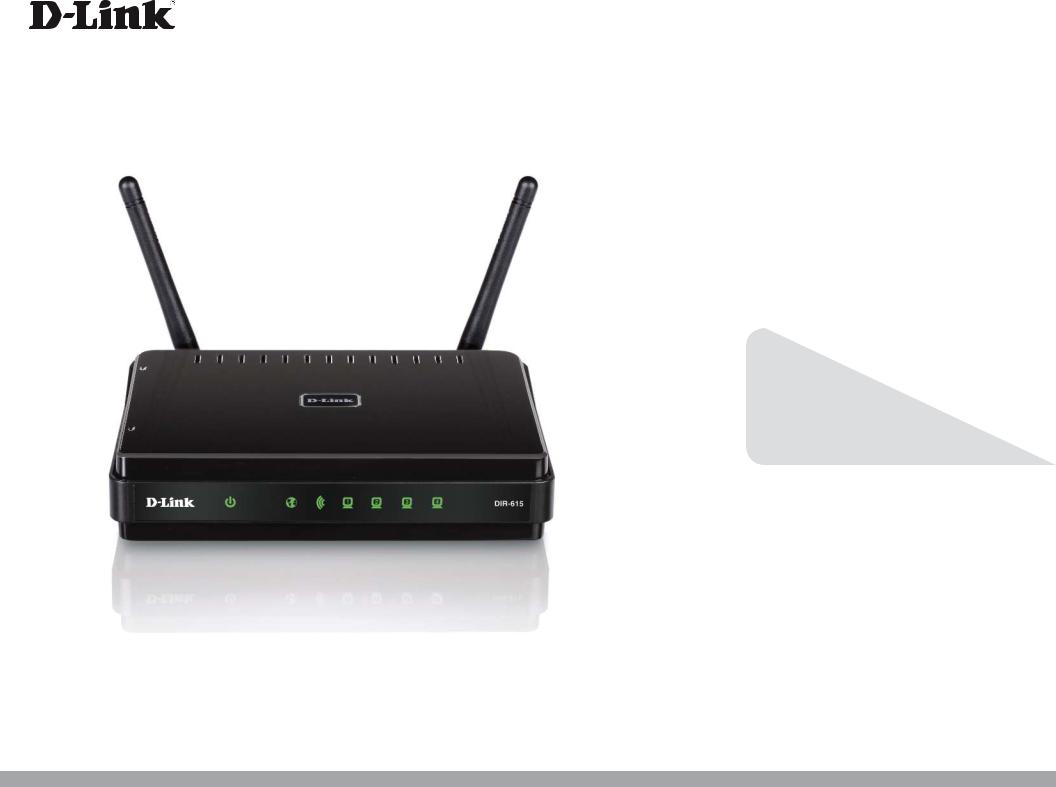
Version 17.0 | 05/03/2013
User Manual
Wireless N Home Router
DIR-615

Preface
D-Link reserves the right to revise this publication and to make changes in the content hereof without obligation to notify any person or organization of such revisions or changes.
Manual Revisions
Revision |
Date |
Description |
17.00 |
May 20, 2013 |
• Initial Release |
|
|
|
Trademarks
D-Link and the D-Link logo are trademarks or registered trademarks of D-Link Corporation or its subsidiaries in the United States or other countries. Microsoft Windows 2000, Microsoft Windows XP, Microsoft Windows Vista, and Microsoft Windows 7 are registered trademarks of the Microsoft Corporation. All other company or product names mentioned herein are trademarks or registered trademarks of their respective companies.
Copyright © 2013 D-Link Corporation
All rights reserved. This publication may not be reproduced, in whole or in part, without prior expressed written permission from D-Link Corporation.
D-Link DIR-615 User Manual |
i |

Table of Contents
Table of Contents
Preface................................................................................. |
i |
Manual Revisions........................................................................... |
i |
Trademarks ...................................................................................... |
i |
Product Overview.............................................................. |
1 |
Package Contents......................................................................... |
1 |
System Requirements................................................................. |
2 |
Features............................................................................................ |
3 |
Hardware Overview..................................................................... |
4 |
Connections ........................................................................... |
4 |
LEDs ........................................................................................... |
5 |
Installation ......................................................................... |
6 |
Before you Begin........................................................................... |
6 |
Wireless Installation Considerations...................................... |
7 |
Connect to Cable/DSL/Satellite Modem.............................. |
8 |
Getting Started.............................................................................. |
9 |
Coniguration................................................................... |
10 |
Web-based Coniguration Utility.......................................... |
10 |
Internet Connection Setup Wizard............................... |
11 |
Manual Coniguration....................................................... |
16 |
Dynamic (Cable)............................................................. |
16 |
Static IP Address............................................................. |
17 |
PPPoE (DSL)...................................................................... |
18 |
PPTP.................................................................................... |
19 |
L2TP .................................................................................... |
20 |
DS-Lite DHCPv6.............................................................. |
21 |
Wireless Settings................................................................. |
22 |
Manual Wireless Network Setup .............................. |
23 |
Network Settings ................................................................ |
25 |
DHCP Server Settings................................................... |
26 |
DHCP Reservation ......................................................... |
27 |
Virtual Server........................................................................ |
28 |
Virtual Servers List.............................................................. |
29 |
Application Rules................................................................ |
30 |
Port Forwarding .................................................................. |
31 |
QoS Engine............................................................................ |
32 |
Network Filters..................................................................... |
33 |
Access Control ..................................................................... |
34 |
Access Control Wizard.................................................. |
34 |
Website Filters...................................................................... |
37 |
Inbound Filters..................................................................... |
38 |
Firewall Settings.................................................................. |
39 |
Advanced Wireless Settings............................................ |
40 |
Wi-Fi Protected Setup ....................................................... |
41 |
Advanced Network Settings........................................... |
42 |
IPv6 .......................................................................................... |
43 |
Auto Detection ............................................................... |
43 |
Static IPv6 ......................................................................... |
45 |
DHCP Autoconiguration ............................................ |
46 |
PPPoE ................................................................................. |
47 |
IPv6 in IPv4 Tunnel ........................................................ |
49 |
IPv6 to IPv4 (6to4).......................................................... |
51 |
6rd ....................................................................................... |
52 |
D-Link DIR-615 User Manual |
ii |

Table of Contents
Local Connectivity Only............................................... |
54 |
Administrator Settings...................................................... |
55 |
Time Settings ....................................................................... |
56 |
SysLog..................................................................................... |
57 |
Email Settings ...................................................................... |
58 |
System Settings................................................................... |
59 |
Update Firmware ................................................................ |
60 |
DDNS....................................................................................... |
61 |
System Check....................................................................... |
62 |
Schedules .............................................................................. |
63 |
Device Information ............................................................ |
64 |
Log ........................................................................................... |
66 |
Statistics ................................................................................. |
67 |
Internet Sessions................................................................. |
68 |
Wireless .................................................................................. |
69 |
Routing Table ....................................................................... |
70 |
IPv6 .......................................................................................... |
71 |
Support .................................................................................. |
72 |
Wireless Security ............................................................. |
73 |
What is WPA?................................................................................ |
73 |
Wireless Network Setup Wizard ............................................ |
74 |
Add Wireless Device with WPS Wizard................................ |
77 |
Conigure WPA-Personal (PSK)............................................... |
78 |
Conigure WPA-Enterprise (RADIUS).................................... |
79 |
Connect to a Wireless Network ............................................. |
80 |
Windows® 8........................................................................... |
80 |
WPA/WPA2 ....................................................................... |
80 |
Windows® 7........................................................................... |
82 |
Conigure WPS ................................................................ |
85 |
Windows Vista®.................................................................... |
89 |
Conigure WPA/WPA2................................................... |
90 |
Windows® XP........................................................................ |
92 |
Conigure WPA-PSK....................................................... |
93 |
Troubleshooting .............................................................. |
95 |
Wireless Basics ................................................................. |
99 |
Tips........................................................................................ |
101 |
Wireless Modes......................................................................... |
102 |
Networking Basics......................................................... |
103 |
Check your MAC and IP address......................................... |
103 |
Statically Assign an IP address............................................ |
104 |
Technical Speciications................................................ |
105 |
D-Link DIR-615 User Manual |
iii |

Section 1 - Product Overview
ProductPackageOverviewContents
DIR-615 Wireless N Home Router
Ethernet Cable
Power Adapter
User Manual on CD
If any of the above items are missing, please contact your reseller.
Note: Using a power supply with a different voltage rating than the one included with the DIR-615 will cause damage and void the warranty for this product.
D-Link DIR-615 User Manual |
1 |

Section 1 - Product Overview
System Requirements
|
• An Ethernet-based Cable or DSL modem |
|
Network Requirements |
• IEEE 802.11n/g wireless clients |
|
|
• 10/100 Ethernet |
|
|
|
|
|
Computer with the following: |
|
|
• Windows®, Macintosh, or Linux-based |
|
|
operating system |
|
|
• An installed Ethernet adapter |
|
Web-based Coniguration |
Browser Requirements: |
|
• Internet Explorer 6 or higher |
||
Utility Requirements |
• Chrome 2.0 or higher |
|
|
• Firefox 3.0 or higher |
|
|
• Safari 3.0 or higher |
|
|
Windows® Users: Make sure you have the latest version of |
|
|
Java installed. Visit |
ww.java.com to download the latest |
|
version. |
|
|
|
|
|
|
|
|
Computer with the following: |
|
CD Installation Wizard |
• Windows® |
XP (Service Pack 3), Vista® or |
Windows® 7/8 |
||
Requirements |
• An installed Ethernet adapter |
|
|
||
|
• CD-ROM drive |
|
D-Link DIR-615 User Manual |
2 |

Section 1 - Product Overview
Features
•FasterWireless Networking -The DIR-615 provides a wireless connection at up to 300Mbps* with other 802.11n wireless clients. This capability allows users to participate in real-time activities online, such as video streaming, online gaming, and VOIP calling.
•Compatible with 802.11g Devices - The DIR-615 is still fully compatible with the IEEE 802.11g standard, so it can connect with existing 802.11g PCI, USB and cardbus adapters.
•Advanced Firewall Features - The web-based user interface displays a number of advanced network management features including which help to protect your network from unauthorized access and malicious attacks.
•Content Filtering - Easily applied content and access filtering based on MAC address, URL, and/or domain name.
•Filter Scheduling - Set your own schedules, allowing you to control when your filters and access controls are activated.
•Secure Multiple/Concurrent Sessions - The DIR-615 can pass through VPN sessions. It supports multiple and concurrent IPSec and PPTP sessions, so users behind the DIR-615 can securely access corporate networks.
•User-friendly SetupWizard - The easy-to-use web-based user interface includes a setup wizard which will walk you through the steps to set up your wireless router, access the Internet, and enable wireless security.
* Maximum wireless signal rate derived from IEEE Standard 802.11g and 802.11n specifications. Actual data throughput will vary. Network conditions and environmental factors, including volume of network traffic, building materials and construction, and network overhead, may lower actual data throughput rate. Environmental conditions may adversely affect wireless signal range.
D-Link DIR-615 User Manual |
3 |
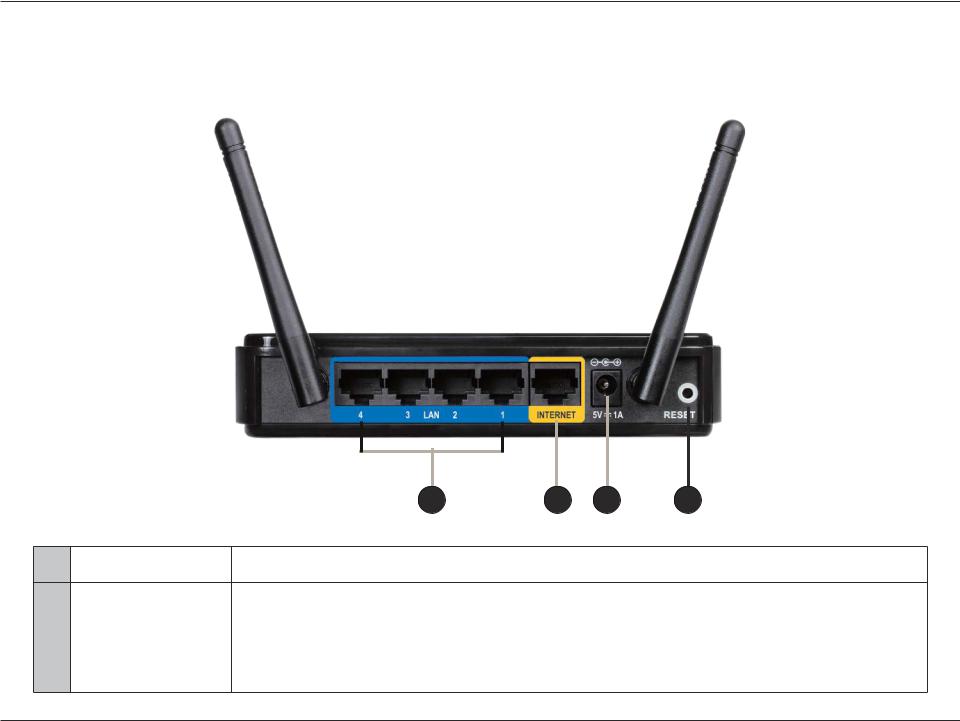
Section 1 - Product Overview
Hardware Overview
Connections
1 |
2 |
3 |
4 |
1LAN Ports (1-4) Connect Ethernet devices such as computers, switches, and hubs.
2 |
Internet Port |
Connect your DSL, cable modem or other Internet connection here to provide Internet connectivity to |
|
the router. |
|||
|
|
||
3 |
Power Receptor |
Receptor for the supplied power adapter. |
|
|
|
|
|
4 |
Reset |
Pressing the Reset button restores the router to its original factory default settings. |
D-Link DIR-615 User Manual |
4 |
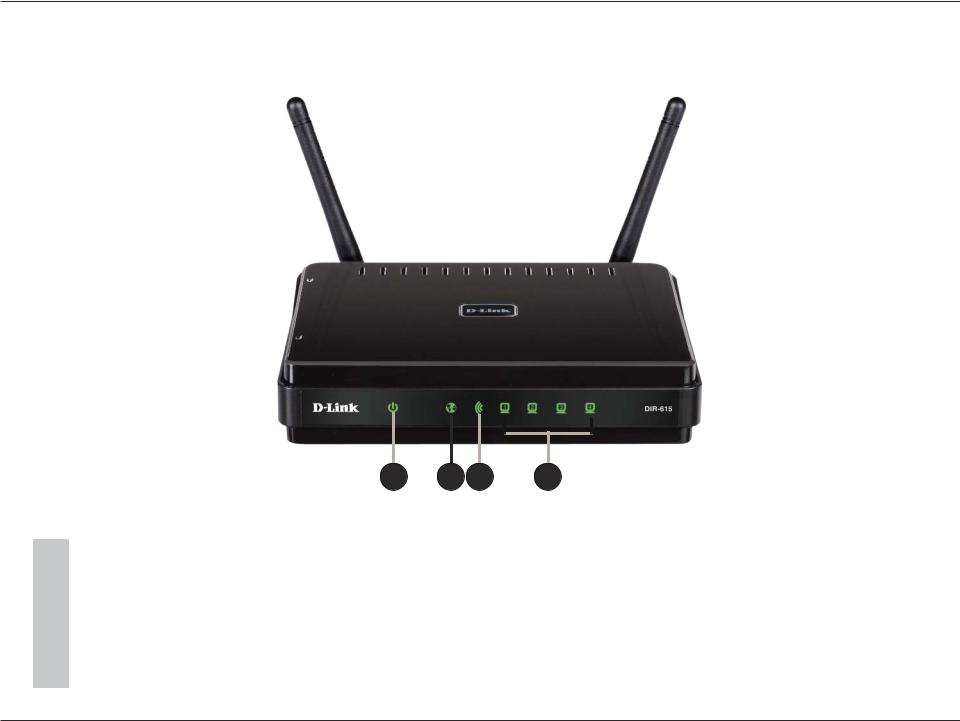
Section 1 - Product Overview
Hardware Overview
LEDs
1 |
2 |
3 |
4 |
1 |
Power LED |
A solid green light indicates a proper connection to the power supply. The light will blink green during the |
|
WPS process. The light will be solid orange during boot up. |
|||
|
|
||
2 |
Internet LED |
A solid light indicates connection on the Internet port. This LED blinks during data transmission. |
|
|
|
|
|
3 |
WAN LED |
A solid light indicates that the wireless segment is ready. This LED blinks during wireless data transmission. |
|
|
|
|
|
4 |
Local Network LEDs |
A solid light indicates a connection to an Ethernet-enabled computer on ports 1-4. This LED blinks during |
|
data transmission. |
|||
|
|
D-Link DIR-615 User Manual |
5 |

Section 2 - Installation
Installation
This section will walk you through the installation process. Placement of the router is very important. Do not place the router in an enclosed area such as a closet, cabinet, or in an attic or garage.
Before you Begin
•Please configure the router with the computer that was last connected directly to your modem.
•You can only use the Ethernet port on your modem. If you were using the USB connection before using the router, then you must turn off your modem, disconnect the USB cable and connect an Ethernet cable to the Internet port on the router, and then turn the modem back on. In some cases, you may need to call your ISP to change connection types (USB to Ethernet).
•If you have DSL and are connecting via PPPoE, make sure you disable or uninstall any PPPoE software such as WinPoet, Broadjump, or EnterNet 300 from your computer or you will not be able to connect to the Internet.
•When running the Setup Wizard from the included CD, make sure the computer you are running the CD from is connected to the Internet, or the wizard will not work. If you have disconnected any hardware, re-connect your computer back to the modem and make sure you are online.
D-Link DIR-615 User Manual |
6 |

Section 2 - Installation
Wireless Installation Considerations
The D-Link wireless router lets you access your network using a wireless connection from virtually anywhere within the operating range of your wireless network. However, keep in mind that the number, thickness, and location of walls, ceilings, or other objects that the wireless signals must pass through, may limit the range. Typical ranges vary depending on the types of materials and background RF (radio frequency) noise in your usage area. You can optimize wireless range and signal strength by following these basic guidelines:
Keep the number of walls and ceilings between the router and other network devices to a minimum - each wall or ceiling can reduce your network’s range by up to 30 meters (98 feet). Position your devices so that the number of walls or ceilings in the signal’s path is minimized.
Be aware of the direct line between network devices. A wall that is 0.5 meters thick (1.5 feet) appears to be almost 1 meter (3 feet) thick at a 45-degree angle. At a 2-degree angle it appears over 14 meters (42 feet) thick! Position devices so that the signal will travel straight through a wall or ceiling (instead of at an angle) for better reception.
Building materials make a difference. A solid metal door or aluminum studs may have a detrimental effect on range. Try to position access points, wireless routers, and computers so that the signal passes through drywall or open doorways. Materials and objects such as glass, steel, metal, walls with insulation, water (fish tanks), mirrors, file cabinets, brick, and concrete can degrade your wireless signal.
Keep your product away (at least 3-6 feet or 1-2 meters) from electrical devices or appliances that generate RF noise.
If you are using 2.4 GHz cordless phones or X-10 (wireless products such as ceiling fans, lights, and home security systems), your wireless connection may degrade dramatically or drop completely. Make sure your 2.4 GHz phone base is as far away from your wireless devices as possible. The base transmits a signal even if the phone is not in use.
D-Link DIR-615 User Manual |
7 |

Section 2 - Installation
Connect to Cable/DSL/Satellite Modem
If you are connecting the router to a cable/DSL/satellite modem, please follow the steps below:
1.Place the router in an open and central location. Do not plug the power adapter into the router.
2.Turn the power off on your modem. If there is no on/off switch, then unplug the modem’s power adapter. Shut down your computer.
3.Unplug the Ethernet cable (that connects your computer to your modem) from your computer and plug it into the Internet port on the router.
4.Plug the Ethernet cable that came with your router into one of the four LAN ports on the router. Plug the other end into the Ethernet port on your computer.
5.Turn on or plug in your modem. Wait for the modem to boot (about 30 seconds).
6.Plug the power adapter to the router and connect to a power outlet. Wait about 30 seconds for the router to boot.
7.Turn on your computer.
8.Verify the link lights on the router. The power light, Internet light, and the LAN light (the port that your computer is plugged into) should be lit. If not, make sure your computer, modem, and router are powered on and verify the cable connections are correct.
9.Skip to “Configuration” on page 10 to configure your router.
D-Link DIR-615 User Manual |
8 |
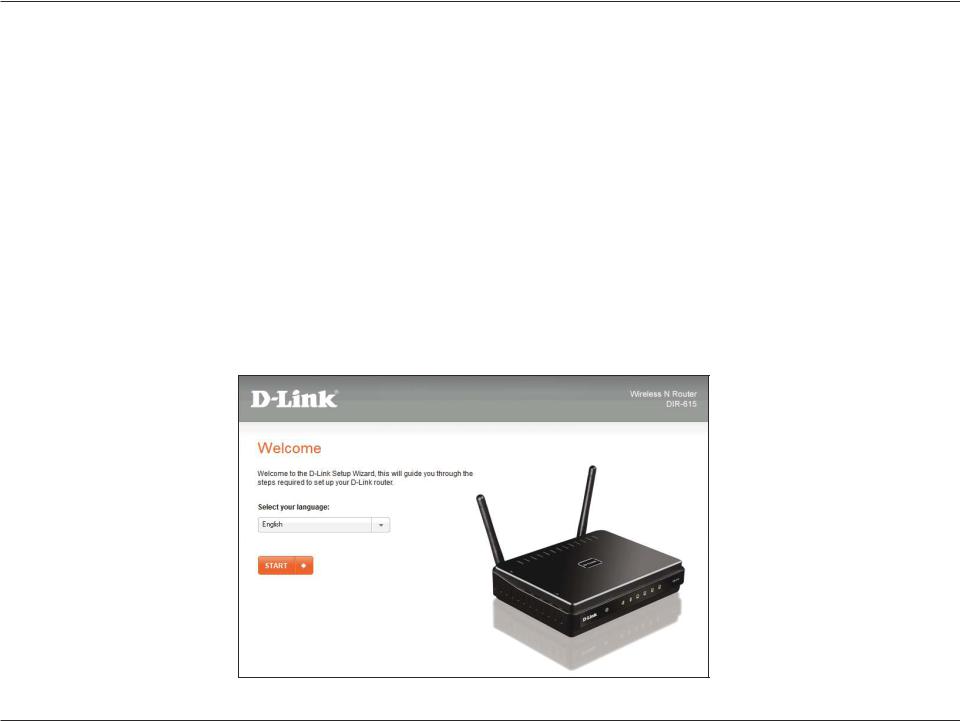
Section 2 - Installation
Getting Started
The DIR-615 includes a Quick Router Setup Wizard CD. Follow the simple steps below to run the setup wizard to guide you quickly through the installation process. Insert the wizard CD in the CD-ROM drive. The step-by-step instructions that follow are shown in Windows® XP. The steps and screens are similar for the other Windows operating systems.
If the CD autorun function does not automatically start on your computer, go to Start > Run. In the run box type “D:\DWizard.exe” (where D: represents the drive letter of your CD-ROM drive).You can also use your operating system’s file explorer to navigate to your CD drive and locate the “DWizard” file.
When the screen below appears, click Start.
Note: It is recommended that you make a record of your SSID and security key, and login password, on the provided CD holder.
D-Link DIR-615 User Manual |
9 |
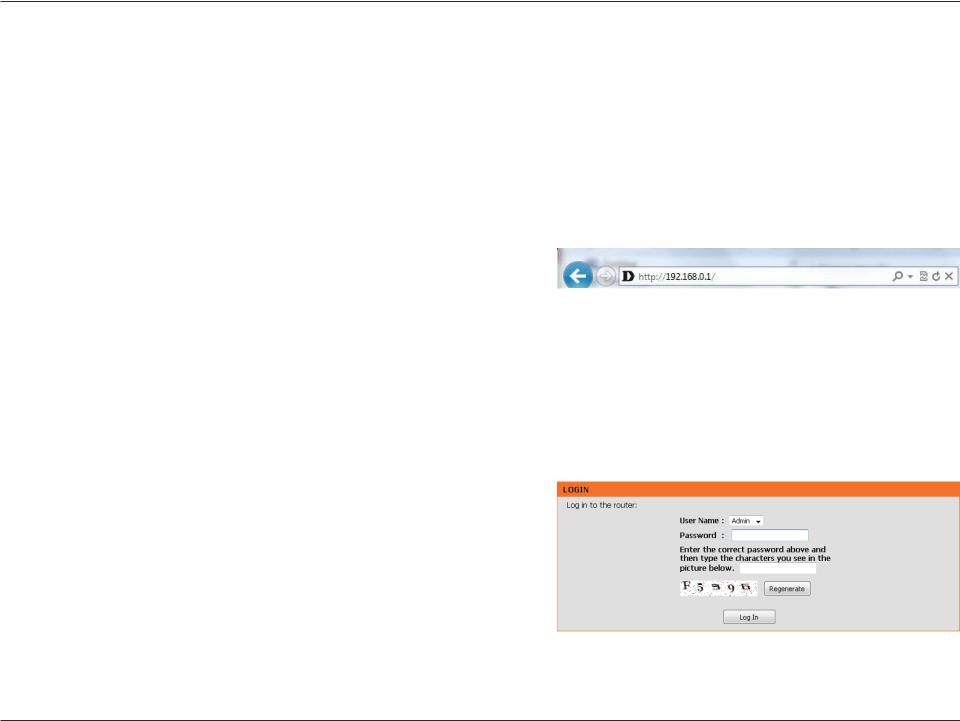
Section 3 - Coniguration
Configuration
This section will show you how to configure your new D-Link wireless router using the web-based configuration utility.
Web-based Configuration Utility
To access the configuration utility, open a web-browser such as Internet Explorer and enter the IP address of the router (192.168.0.1).
You may also connect using the NetBIOS name in the address bar (http:// dlinkrouter.local.).
Select Admin from the drop-down menu and then enter your password. Leave the password blank by default. If graphical authentication has been enabled, type in the graphical authentication code (if you cannot read it, click Regenerate). The graphical authentication will be disabled by default.
If you get a Page Cannot be Displayed error, please refer to“Troubleshooting”on page 95 for assistance.
D-Link DIR-615 User Manual |
10 |
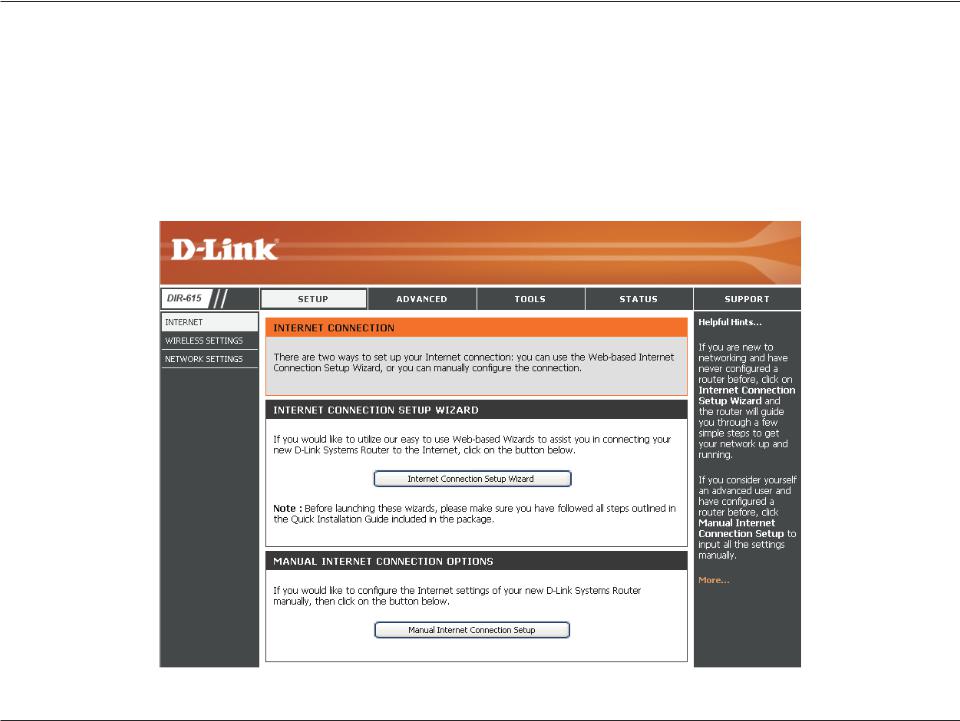
Section 3 - Coniguration
Internet Connection Setup Wizard
Once logged into the web interface of the router, the Setup > Internet page will appear. Click the Internet Connection Setup Wizard button to quickly configure your router using the setup wizard.
If you want to enter your settings without running the wizard, click Manual Internet ConfigurationWizard and skip to page 16.
D-Link DIR-615 User Manual |
11 |
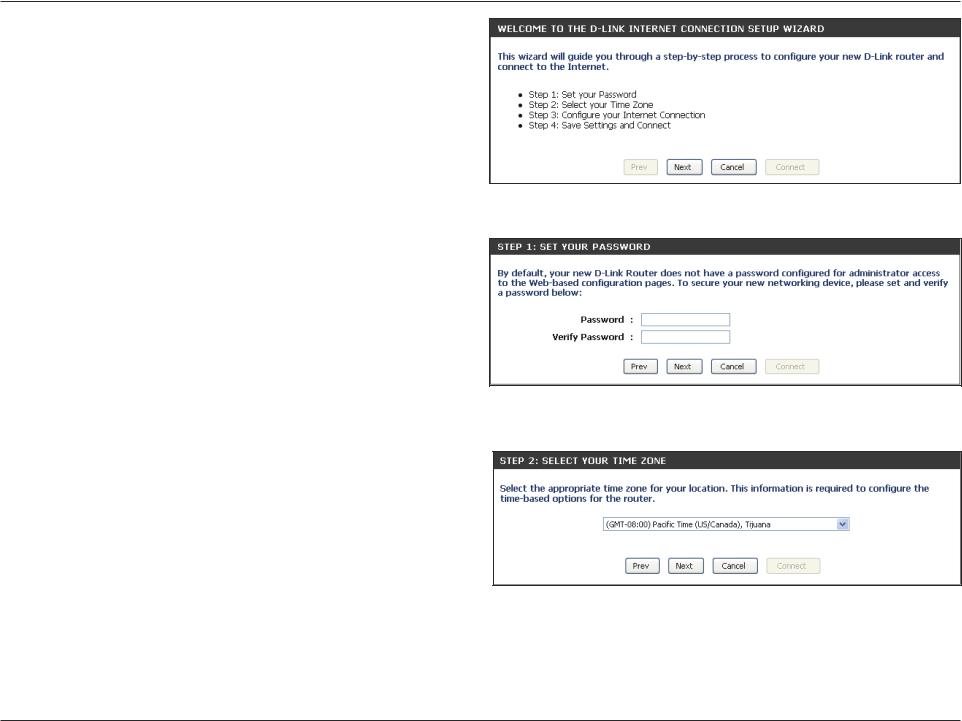
Section 3 - Coniguration
Click Next to continue.
Create a new password and then click Next to continue. You will need this password to access the web-based configuration utility.
Select your time zone from the drop-down menu and then click Next to continue.
D-Link DIR-615 User Manual |
12 |

Section 3 - Coniguration
Select the type of Internet connection you use and then click Next to continue.
If you selected Dynamic, you may need to enter the MAC address of the computer that was last connected directly to your modem. If you are currently using that computer, click Clone Your PC’s MAC Address.
The host name is optional but may be required by some ISPs. The default host name is the device name of the router and may be changed.
Under DNS Settings, you may need to enter the primary DNS server address provided to you by your ISP. Click Next to continue.
D-Link DIR-615 User Manual |
13 |
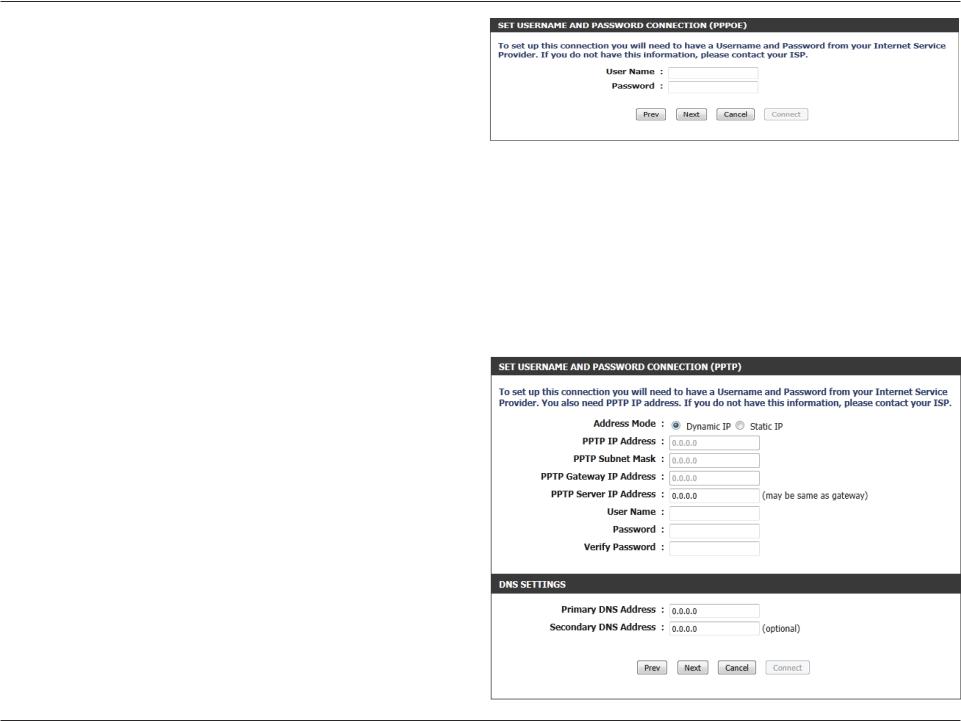
Section 3 - Coniguration
If you selected PPPoE, enter your PPPoE username and password. Click Next to continue.
Note: Make sure to remove any PPPoE software from your computer. The software is no longer needed and will not work through a router.
If you selected PPTP, select whether you require a Dynamic IP or Static IP connection. If you selected Static, enter the IP address, subnet mask, gateway IP address, and server IP address provided to you by your ISP. Next, enter your PPTP username and password.
Under DNS Settings, you may need to enter the primary DNS server address provided to you by your ISP.
Click Next to continue.
D-Link DIR-615 User Manual |
14 |
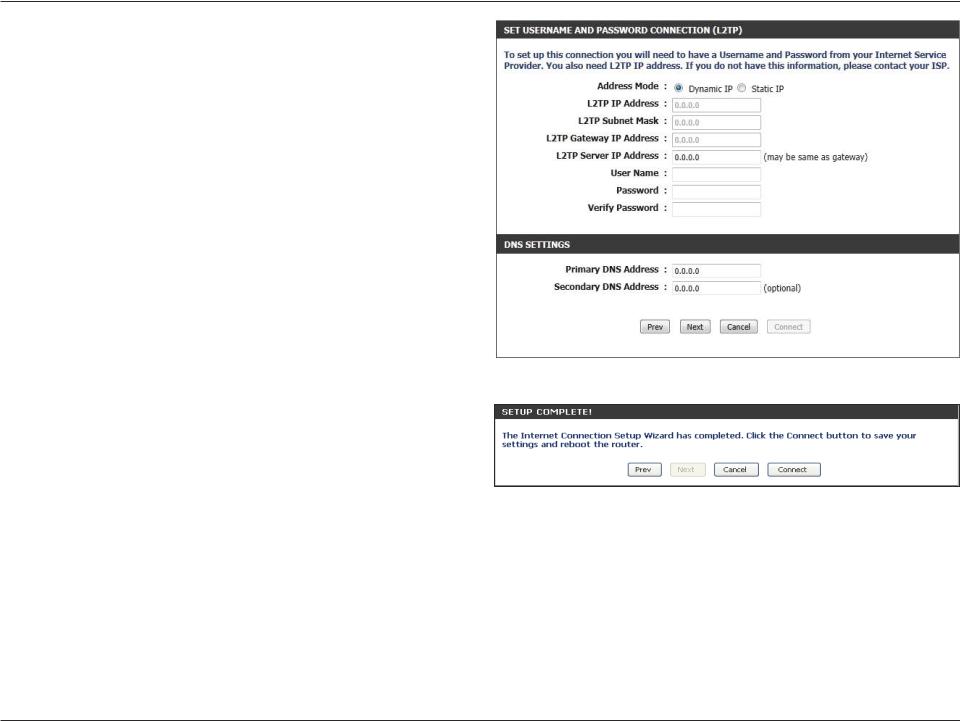
Section 3 - Coniguration
If you selected L2TP, select whether you require a Dynamic IP or Static IP connection. If you selected Static, enter the IP address, subnet mask, gateway IP address, and server IP address provided to you by your ISP. Next, enter your PPTP username and password.
Under DNS Settings, you may need to enter the primary DNS server address provided to you by your ISP.
Click Next to continue.
The setup is now complete. Click the Connect to save your settings. Please allow 1-2 minutes to connect.
D-Link DIR-615 User Manual |
15 |
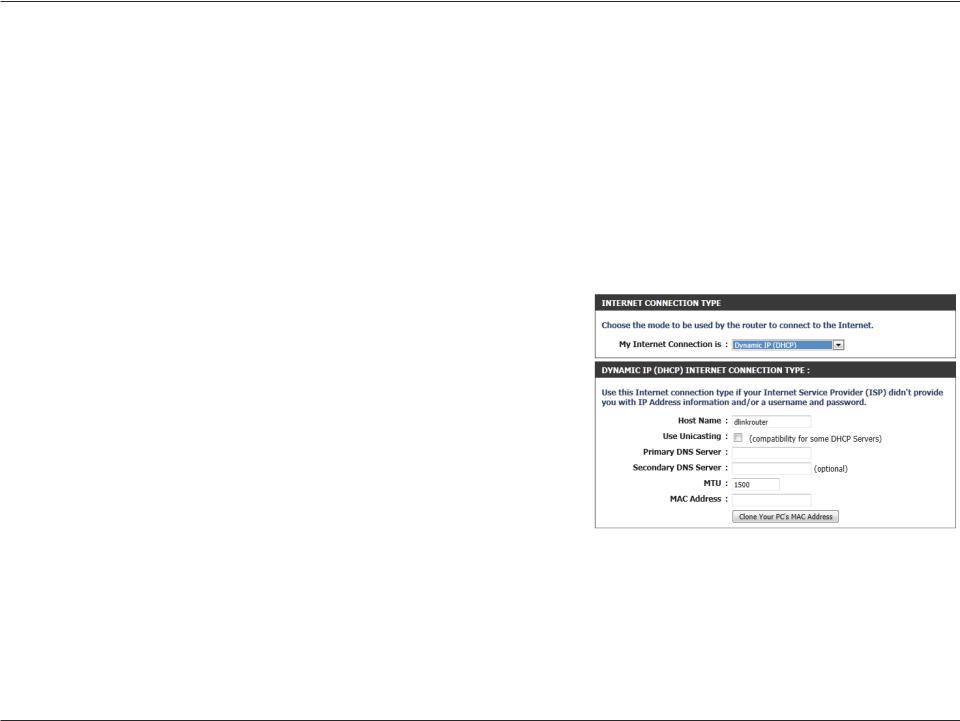
Section 3 - Coniguration
Manual Configuration
Dynamic (Cable)
If you opt to set up your Internet connection manually, you will be redirected to a WAN page that allows you to select your Internet type and enter the correct configuration parameters.
Select your Internet connection type using the “My Internet Connection is” dropdown menu.
At any stage, you can click on the Save Settings button to accept the changes made, or click on the Don’t Save Settings button to discard the changes made.
My Internet Select Dynamic IP (DHCP) to obtain IP address information automatically Connection: from your ISP. Select this option if your ISP does not give you any IP numbers
to use. This option is commonly used for cable modem services.
Host Name: The host name is optional but may be required by some ISPs. Leave blank if you are not sure.
Use Check the box if you are having problems obtaining an IP address from
Unicasting: your ISP.
Primary/ Enter the primary and secondary DNS server IP addresses assigned by your
Secondary ISP.These addresses are usually obtained automatically from your ISP. Leave
DNS Server: at 0.0.0.0 if you did not specifically receive these from your ISP.
MTU: MaximumTransmission Unit - you may need to change the MTU for optimal performance with your specific ISP. 1500 is the default MTU.
MAC The default MAC address is set to the Internet port’s physical interface MAC Address: address on the broadband router. It is not recommended that you change the default MAC address unless required by your ISP. You can use the Clone Your PC’s MAC Address button to replace the Internet port’s MAC address
with the MAC address of your Ethernet card.
D-Link DIR-615 User Manual |
16 |
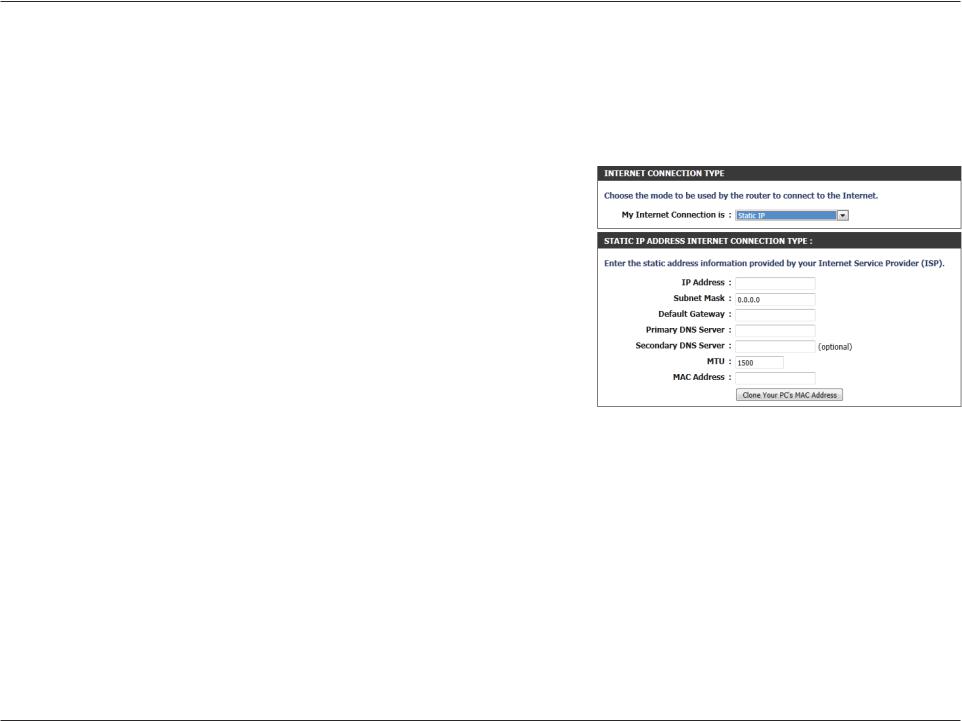
Section 3 - Coniguration
Static IP Address
Select Static IP Address if all the Internet port’s IP information is provided to you by your ISP. You will need to enter in the IP address, subnet mask, gateway address, and DNS address(es) provided to you by your ISP. Each IP address entered in the fields must be in the appropriate IP form, which are four octets separated by a dot (x.x.x.x). The router will not accept an IP address if it is not in this format.
IP Address:
Subnet Mask:
Default Gateway:
Primary DNS
Server:
Secondary DNS
Server:
MTU:
MAC Address:
Enter the IP address assigned by your ISP.
Enter the subnet mask assigned by your ISP.
Enter the gateway assigned by your ISP.
The primary DNS server information will be supplied by your ISP (Internet Service Provider.)
The secondary DNS server information will be supplied by your ISP
Maximum Transmission Unit - you may need to change the MTU for optimal performance with your specific ISP. 1500 is the default MTU.
The default MAC address is set to the Internet port’s physical interface MAC address on the broadband router. It is not recommended that you change the default MAC address unless required by your ISP. You can use the Clone Your PC’s MAC Address button to replace the Internet port’s MAC address with the MAC address of your Ethernet card.
D-Link DIR-615 User Manual |
17 |
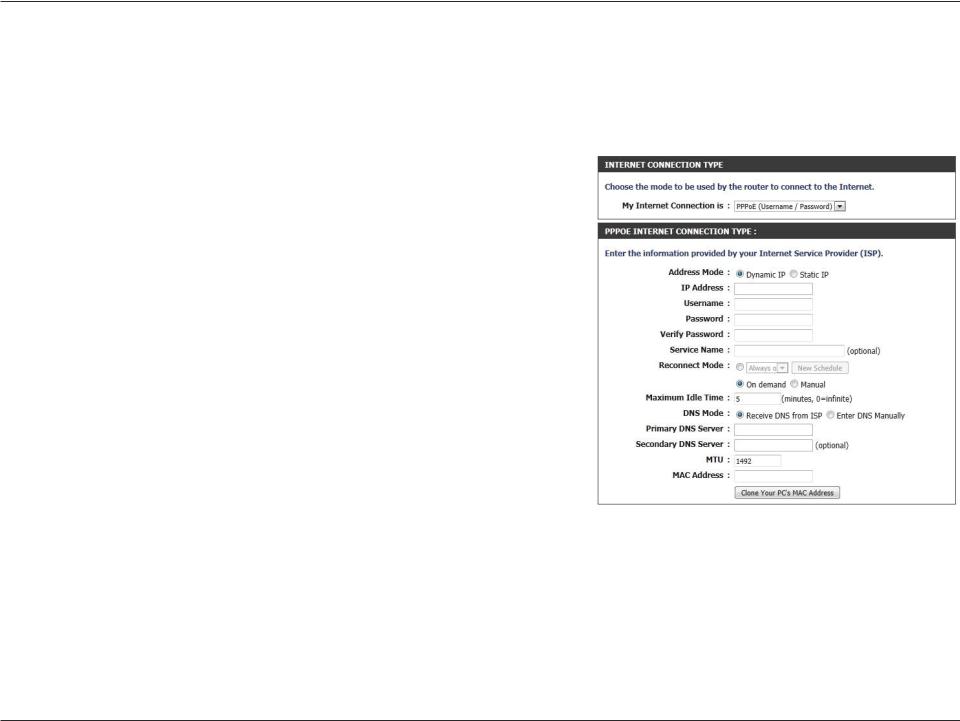
Section 3 - Coniguration
PPPoE (DSL)
Choose PPPoE (Point to Point Protocol over Ethernet) if your ISP uses a PPPoE connection. Your ISP will provide you with a username and password. This option is typically used for DSL services. Make sure to remove any PPPoE software from your computer. The software is no longer needed and will not work through a router.
My Internet Select PPPoE (Username/Password) from the drop-down menu.
Connection:
Address Mode: Select Static if your ISP assigned you the IP address, subnet mask, gateway, and DNS server addresses. In most cases, select Dynamic.
IP Address: Enter the IP address (Static PPPoE only).
User Name: Enter your PPPoE user name.
Password: Enter your PPPoE password and then retype the password in the next box.
Service Name: Enter the ISP service name (optional).
Reconnection Select either Always-on, On-Demand, or Manual. You can also select
Mode: a schedule for connection.
Maximum Idle Enter a maximum idle time during which the Internet connection is Time: maintained during inactivity. To disable this feature, set your reconnect
mode to Always-on.
DNS Addresses: Enter the primary and secondary DNS server addresses (static PPPoE only).
MTU: Maximum Transmission Unit - you may need to change the MTU for optimal performance with your specific ISP. 1492 is the default MTU.
MAC Address: The default MAC address is set to the Internet port’s physical interface MAC address on the broadband router. It is not recommended that you change the default MAC address unless required by your ISP. You can use the Clone Your PC’s MAC Address button to replace the Internet port’s MAC address with the MAC address of your Ethernet card.
D-Link DIR-615 User Manual |
18 |
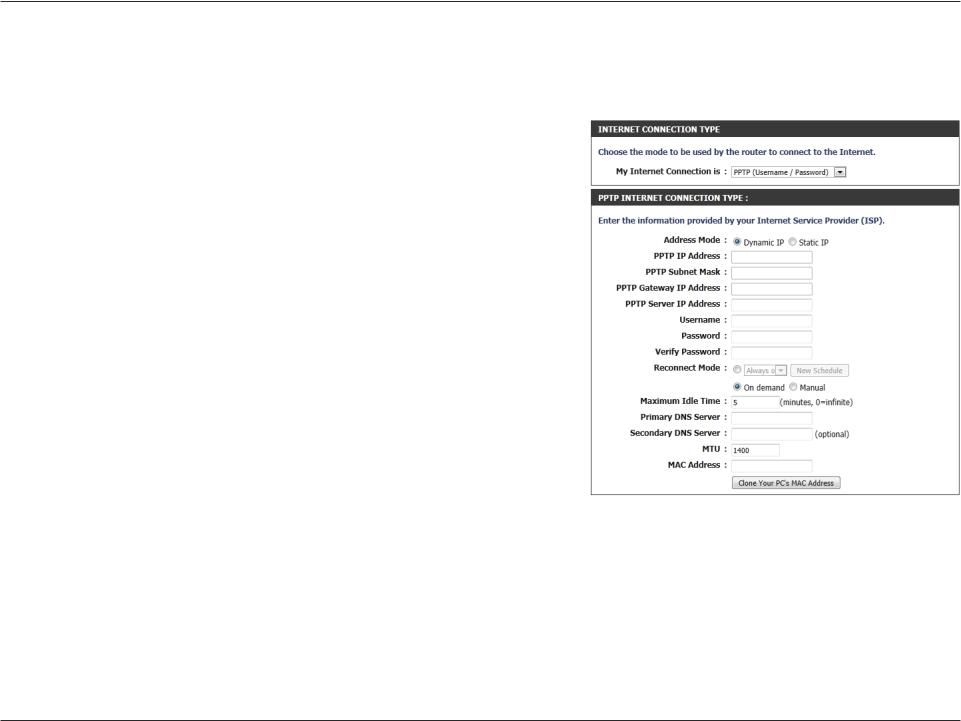
Section 3 - Coniguration
PPTP
Choose PPTP (Point-to-Point-Tunneling Protocol ) if your ISP uses a PPTP connection. Your ISP will provide you with a username and password. This option is typically used for DSL services.
Address Mode: Select Static if your ISP assigned you the IP address, subnet mask, gateway, and DNS server addresses. In most cases, select Dynamic.
PPTP IP Address: Enter the IP address (Static PPTP only).
PPTP Subnet Enter the primary and secondary DNS server addresses (Static PPTP only).
Mask:
PPTP Gateway: Enter the gateway IP Address provided by your ISP.
PPTP Server IP: Enter the server IP provided by your ISP (optional).
Username: Enter your PPTP username.
Password: Enter your PPTP password and then retype the password in the next box.
Reconnect Mode: Select either Always-on, On-Demand, or Manual. You can also select a schedule for connection.
Maximum Idle Enter a maximum idle time during which the Internet connection is Time: maintained during inactivity. To disable this feature, set your reconnect
mode to Always-on.
DNS Servers: The DNS server information will be supplied by your ISP (Internet Service
Provider).
MTU: Maximum Transmission Unit - you may need to change the MTU for optimal performance with your specific ISP. 1400 is the default MTU.
MAC Address: The default MAC address is set to the Internet port’s physical interface MAC address on the broadband router. It is not recommended that you change the default MAC address unless required by your ISP. You can use the Clone Your PC’s MAC Address button to replace the Internet port’s MAC address with the MAC address of your Ethernet card.
D-Link DIR-615 User Manual |
19 |
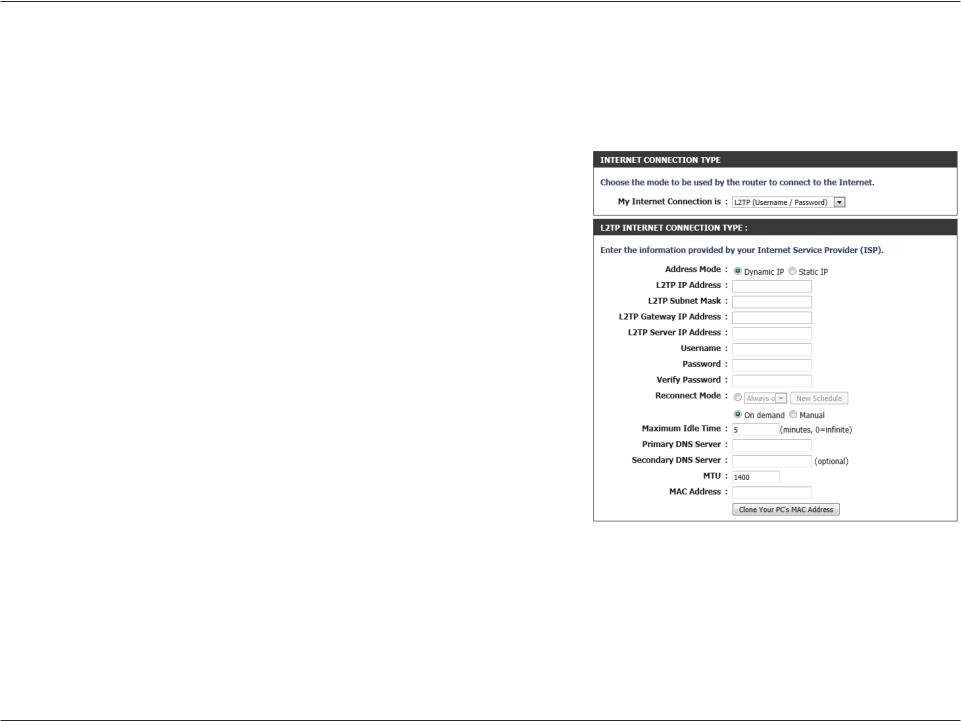
Section 3 - Coniguration
L2TP
Choose L2TP (Layer 2 Tunneling Protocol) if your ISP uses a L2TP connection. Your ISP will provide you with a username and password. This option is typically used for DSL services.
Address Mode: Select Static if your ISP assigned you the IP address, subnet mask, gateway, and DNS server addresses. In most cases, select Dynamic.
L2TP IP Address: Enter the L2TP IP address supplied by your ISP (Static only).
L2TP Subnet Enter the subnet mask supplied by your ISP (Static only).
Mask:
L2TP Gateway: Enter the gateway IP address provided by your ISP.
L2TP Server IP: Enter the server IP provided by your ISP (optional).
Username: Enter your L2TP username.
Password: Enter your L2TP password and then retype the password in the next box.
Reconnect Select either Always-on, On-Demand, or Manual.You can also select
Mode: a schedule for connection.
Maximum Idle Enter a maximum idle time during which the Internet connection Time: is maintained during inactivity. To disable this feature, set your
reconnect mode to Always-on.
DNS Servers: Enter the primary and secondary DNS server addresses (Static L2TP only).
MTU: Maximum Transmission Unit - you may need to change the MTU for optimal performance with your specific ISP. 1400 is the default MTU.
Clone MAC The default MAC address is set to the Internet port’s physical interface Address: MAC address on the broadband router. It is not recommended that you change the default MAC address unless required by your ISP.
You can use the CloneYour PC’s MAC Address button to replace the Internet port’s MAC address with the MAC address of your Ethernet card.
D-Link DIR-615 User Manual |
20 |
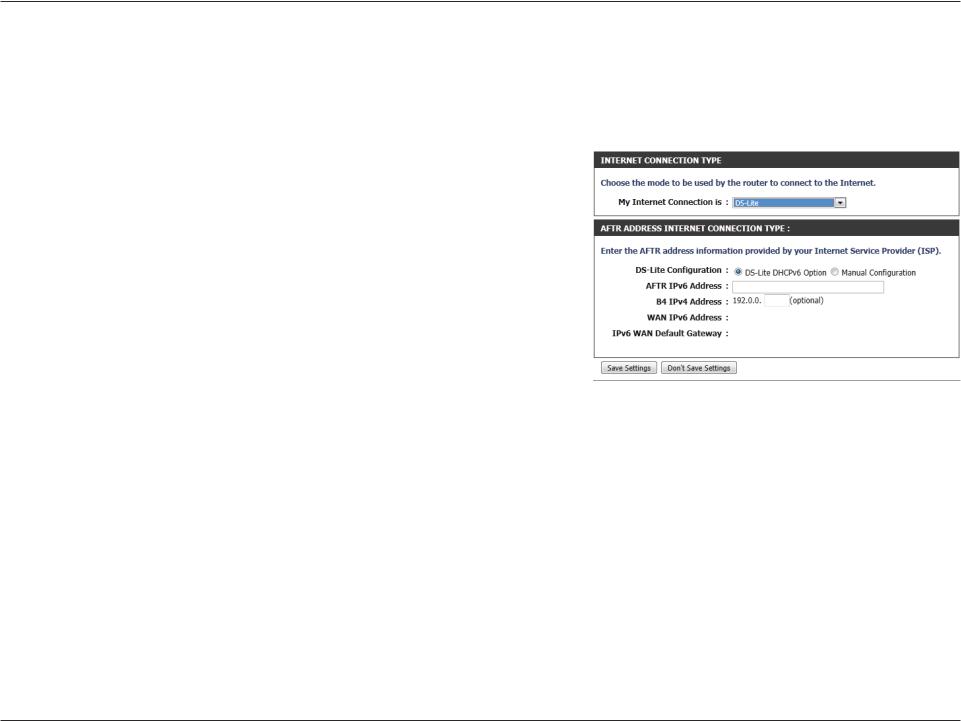
Section 3 - Coniguration
DS-Lite DHCPv6
DS-Lite is an IPv6 connection type. After selecting DS-Lite, the following parameters will be available for coniguration:
DS-Lite Select the DS-Lite DHCPv6 option to let the router allocate the Coniguration: AFTR IPv6 address automatically. Select the Manual Coniguration
to enter the AFTR IPv6 address in manually.
AFTR IPv6 After selecting the manual coniguration option above, the user
Address: can enter the AFTR IPv6 address used here.
B4 IPv4 Address: Enter the B4 IPv4 address value used here.
WAN IPv6 Once connected, the WAN IPv6 address will be displayed here.
Address:
IPv6 WAN Default Once connected, the IPv6 WAN default gateway address will be
Gateway displayed here.
D-Link DIR-615 User Manual |
21 |
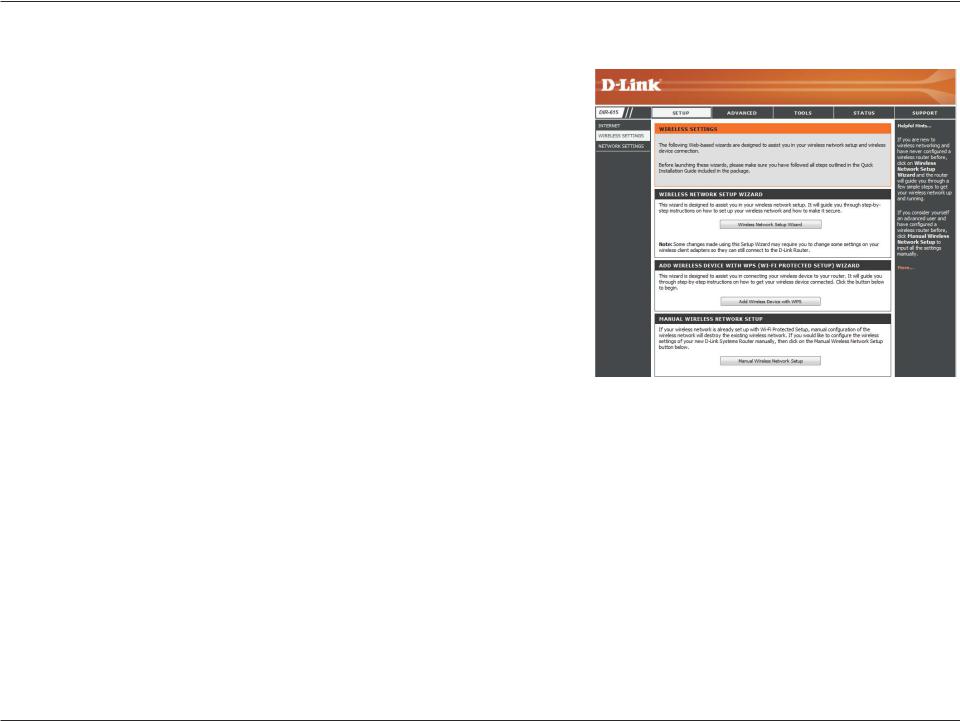
Section 3 - Coniguration
Wireless Settings
If you want to configure the wireless settings on your router using the wizard, click Wireless Network Setup Wizard and refer to “Wireless Network Setup Wizard” on page 74.
Click Add Wireless Device with WPS if you want to add a wireless device using Wi-Fi Protected Setup (WPS) and refer to“Add Wireless Device with WPS Wizard”on page 77.
If you want to manually configure the wireless settings on your router click Manual Wireless Network Setup and refer to the next page.
D-Link DIR-615 User Manual |
22 |
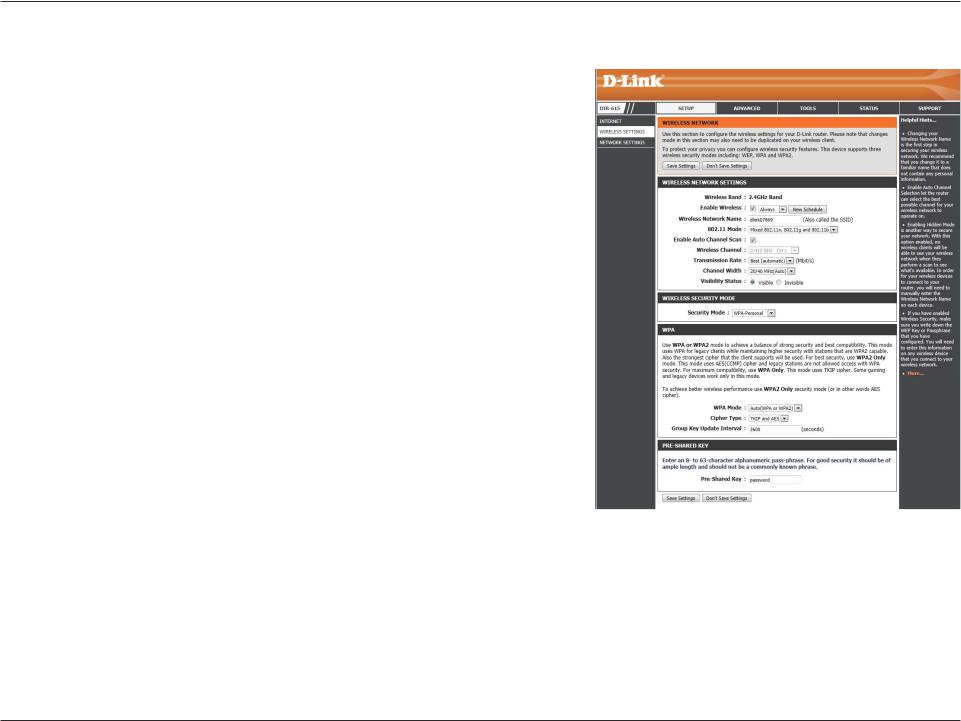
Section 3 - Coniguration
Manual Wireless Network Setup
Enable Wireless: Check the box to enable the wireless function. If you do not want to use wireless, uncheck the box to disable all wireless functions. Click Add New to create your own time schedule to enable the wireless function.
Wireless Service Set Identifier (SSID) is the name of your wireless network. Create Network Name: a name using up to 32 characters. The SSID is case-sensitive.
802.11 Mode: Select one of the following:
802.11b Only - Select if all of your wireless clients are 802.11b. 802.11g Only - Select if all of your wireless clients are 802.11g. 802.11n Only - Select only if all of your wireless clients are 802.11n. Mixed 802.11g and 802.11b - Select if you are using both 802.11b and 802.11g wireless clients.
Mixed 802.11n and 802.11g - Select if you are using a mix of 802.11n and 802.11g wireless clients.
Mixed 802.11n, 802.11b, and 802.11g - Select if you are using a mix of 802.11n, 11g, and 11b wireless clients.
Enable Auto The Auto Channel Scan setting can be selected to allow the DIR-615 Channel Scan: to choose the channel with the least amount of interference.
Wireless Indicates the channel setting for the DIR-615. By default the channel Channel: is set to 6. The channel can be changed to fit the channel setting for an existing wireless network or to customize the wireless network. If
you enable Auto Channel Scan, this option will be greyed out.
Transmission Select the transmission rate. It is strongly suggested to select Best Rate: (Auto) for best performance.
Channel Width: Select the channel width:
Auto 20/40 - Select if you are using both 802.11n and non-802.11n wireless devices.
20MHz - Select if you are not using any 802.11n wireless clients. This is the default setting.
D-Link DIR-615 User Manual |
23 |
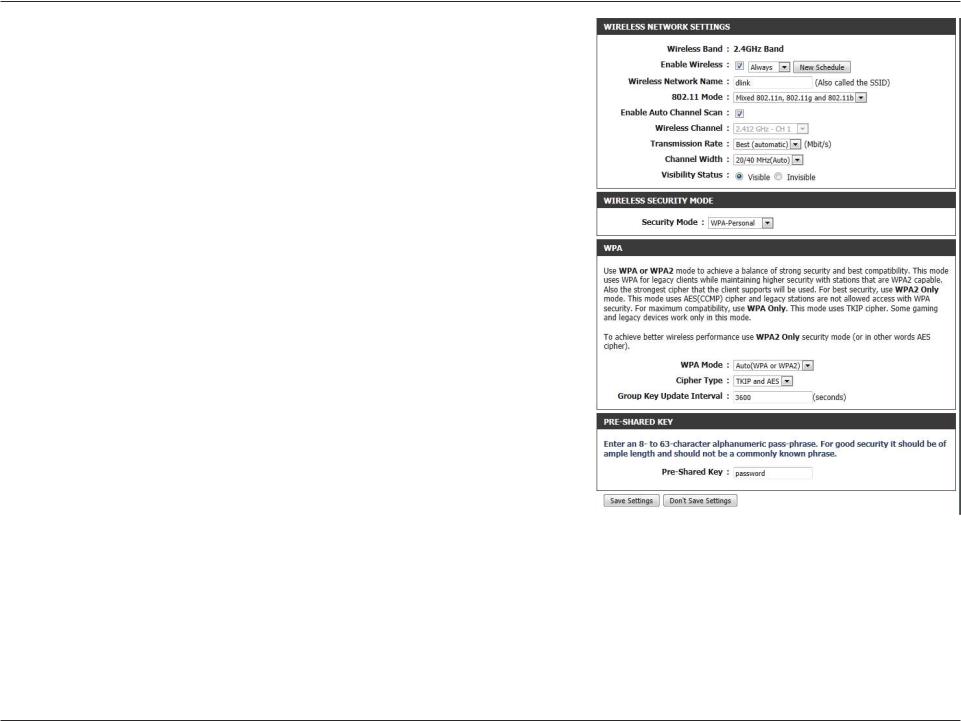
Section 3 - Coniguration
Visibility Status:
Wireless Security
Mode:
Select Invisible if you do not want the SSID of your wireless network to be broadcast by the DIR-615. If Invisible is selected, the SSID of the DIR-615 will not be seen by site survey utilities, so you will have to manually enter the SSID of your DIR-615 in order to connect to it.
Select the type of wireless security encryption that you want to use for your wireless network. For more information regarding how to set up wireless security, please refer to “Wireless Security” on page 73
D-Link DIR-615 User Manual |
24 |
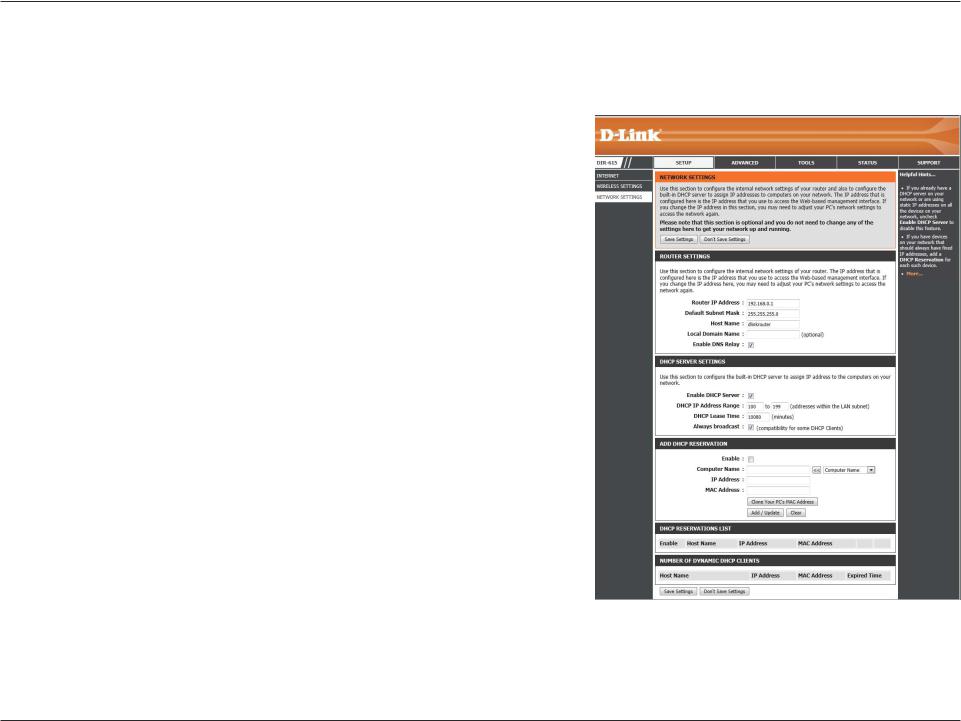
Section 3 - Coniguration
Network Settings
This section will allow you to change the local network settings of the router and to configure the DHCP settings.
IP Address:
Subnet Mask:
Local Domain:
Enable DNS Relay:
Enter the IP address of the router.The default IP address is 192.168.0.1.
Note: If you change the IP address, once you click Apply, you will need to enter the new IP address in your browser in order to access the configuration utility.
Enter the subnet mask. The default subnet mask is 255.255.255.0.
Enter the domain name (optional).
Uncheck the box to transfer the DNS server information from your ISP to your computers. If checked, your computers will use the router for a DNS server.
D-Link DIR-615 User Manual |
25 |
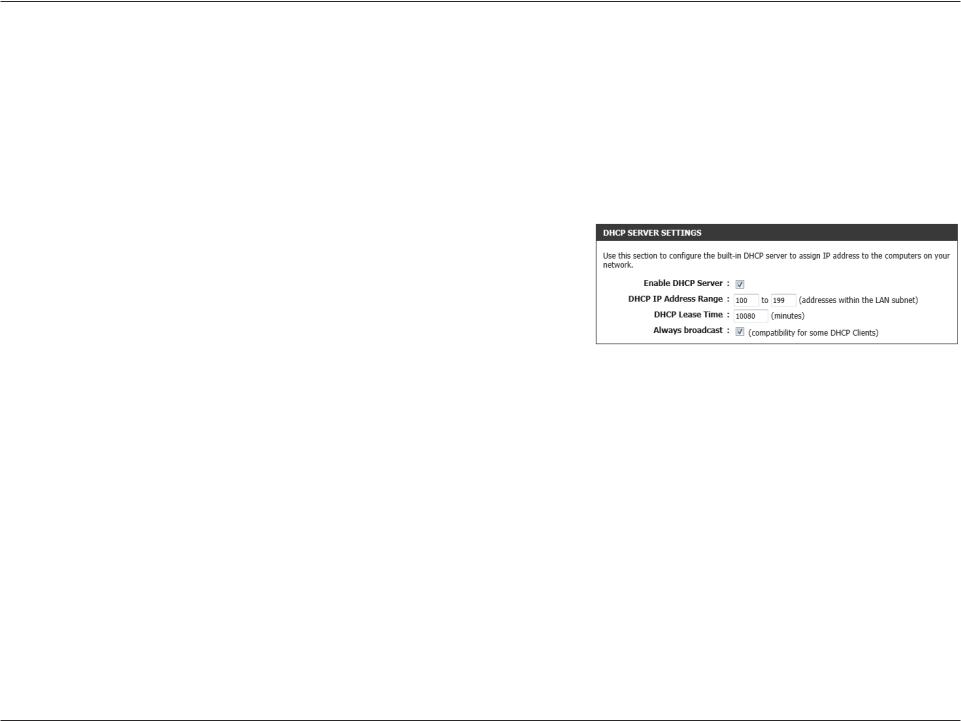
Section 3 - Coniguration
DHCP Server Settings
The DIR-615 has a built-in Dynamic Host Control Protocol (DHCP) server. The DHCP server will automatically assign an IP address to the computers on the LAN/private network. Be sure to set your computers to be DHCP clients by setting their TCP/ IP settings to “Obtain an IP Address Automatically.”When you turn your computers on, they will automatically load the TCP/IP settings provided by the DIR-615. The DHCP server will automatically allocate an unused IP address from the IP address pool to the requesting computer. You must specify the starting and ending address of the IP address pool.
Enable DHCP
Server:
DHCP IP
Address Range:
Lease Time:
Always
Broadcast:
Check this box to enable the DHCP server on your router. Uncheck to disable this function.
Enter the starting and ending IP addresses for the DHCP server’s IP assignment.
Note: If you statically (manually) assign IP addresses to your computers or devices, make sure the IP addresses are outside of this range or you may experience an IP address conflict.
The length of time for the IP address lease. Enter the lease time in minutes.
Enable this function to ensure compatibility with some DHCP clients.
D-Link DIR-615 User Manual |
26 |
